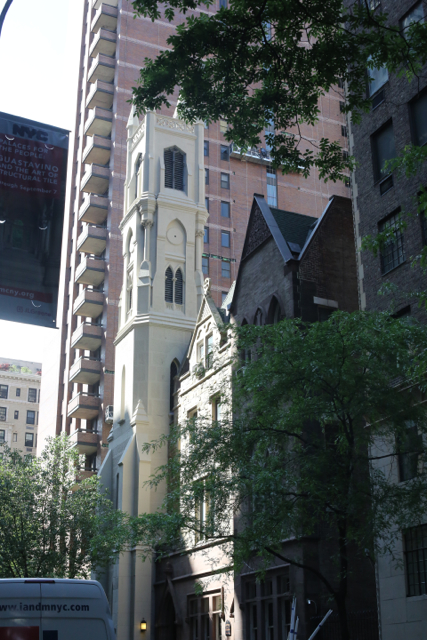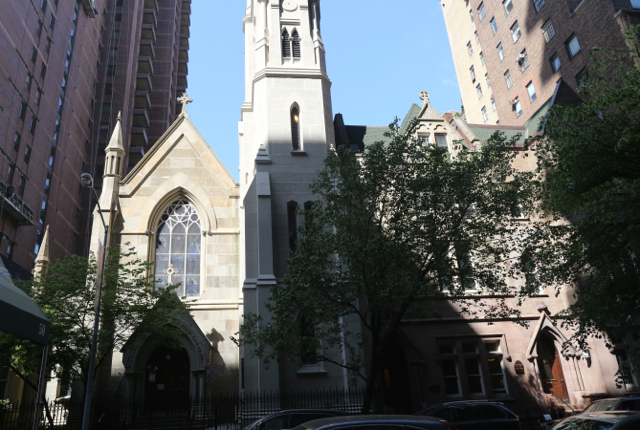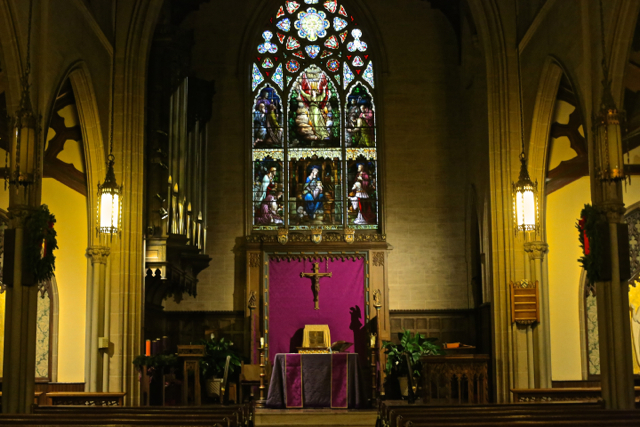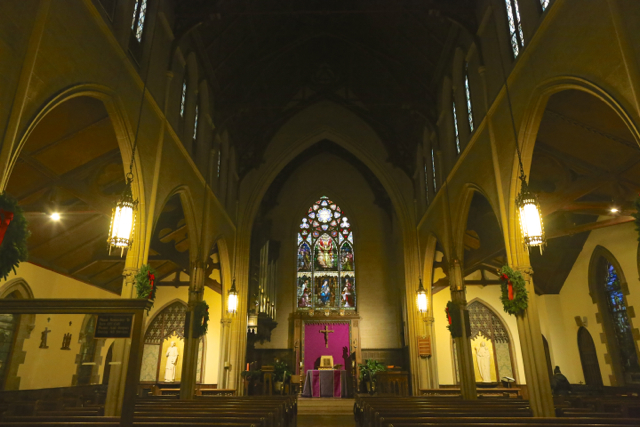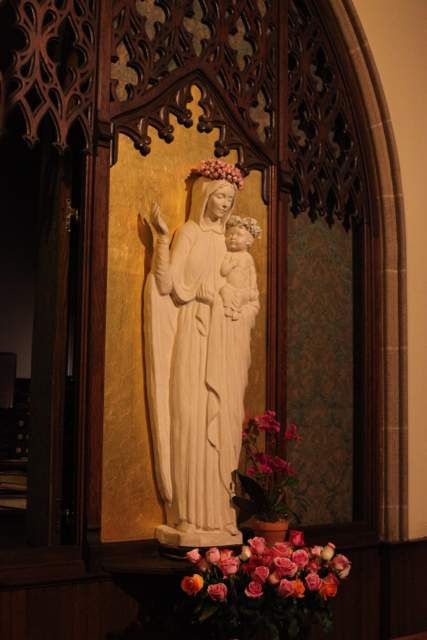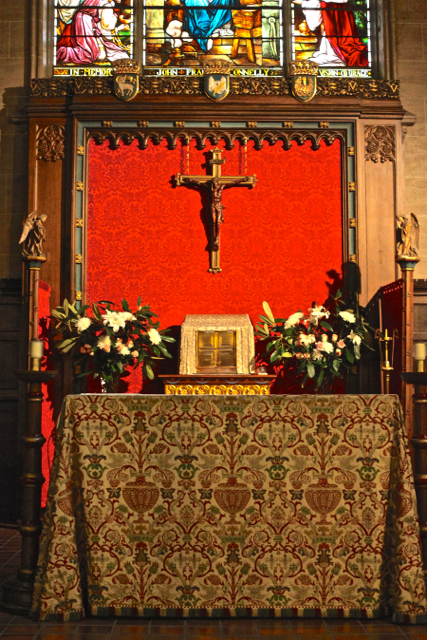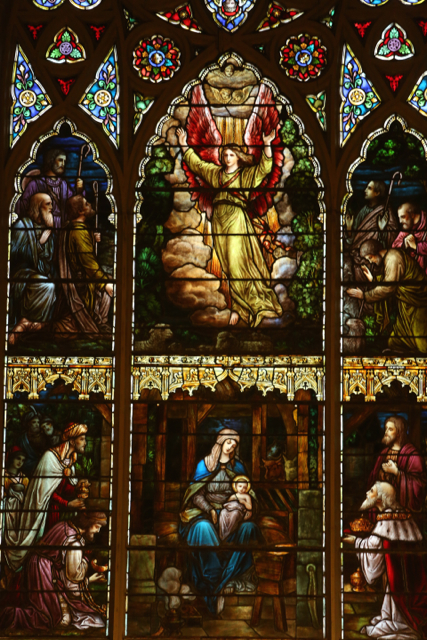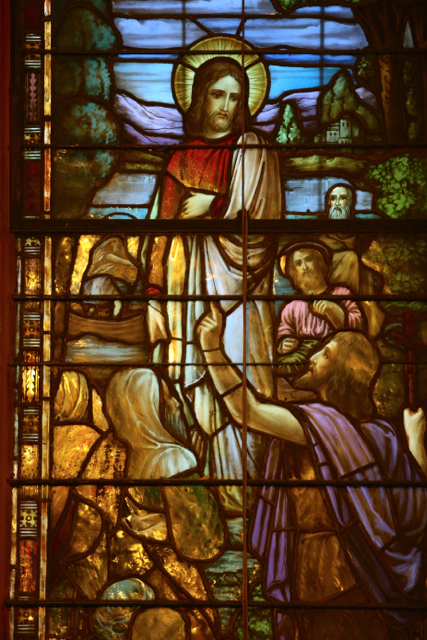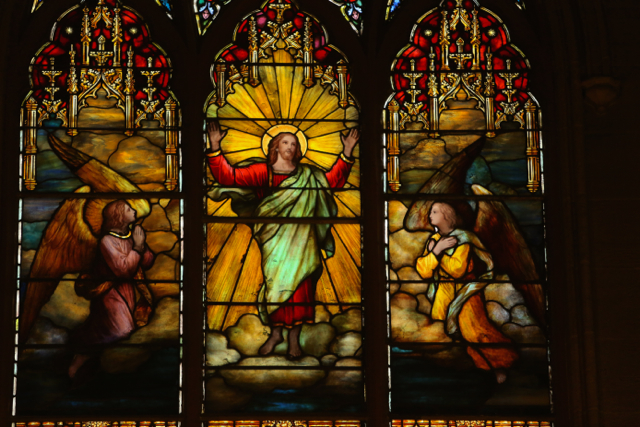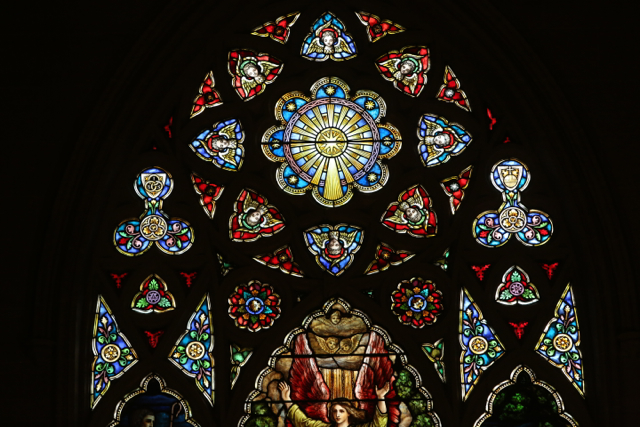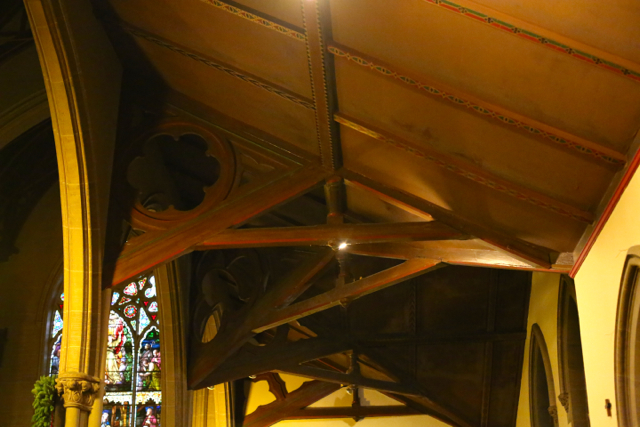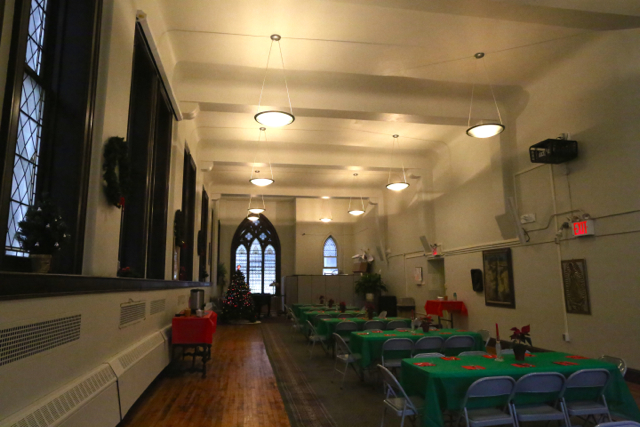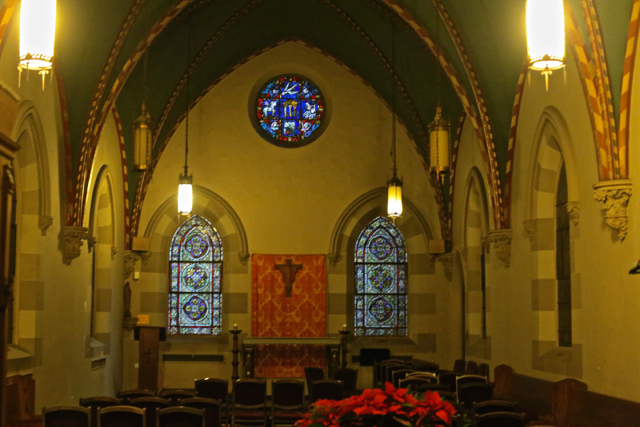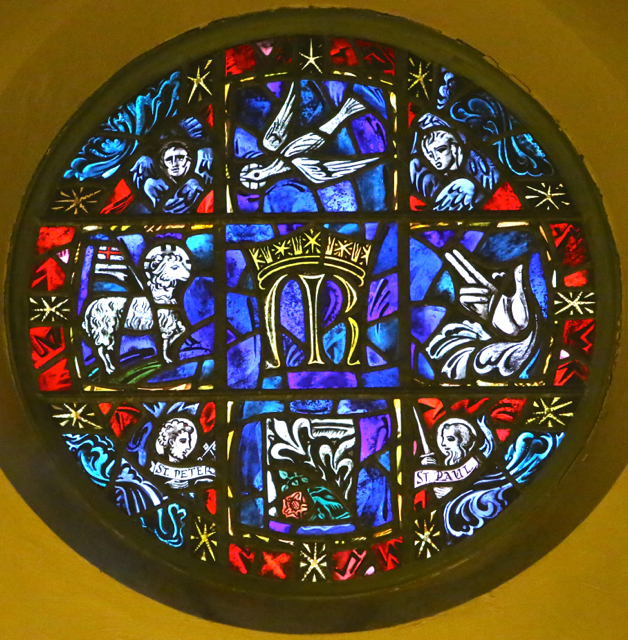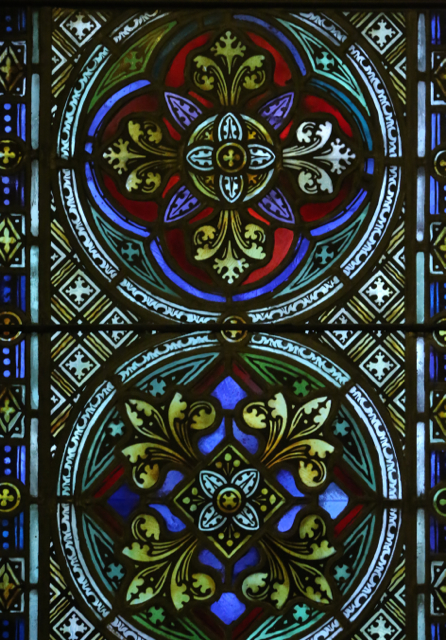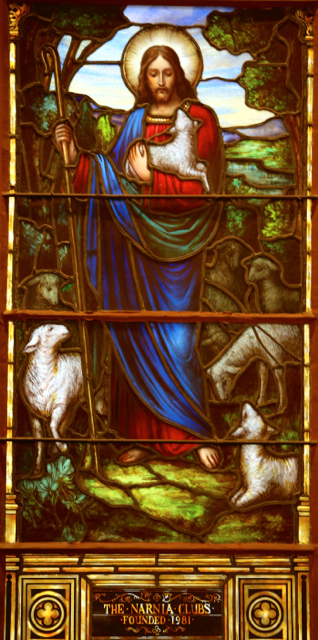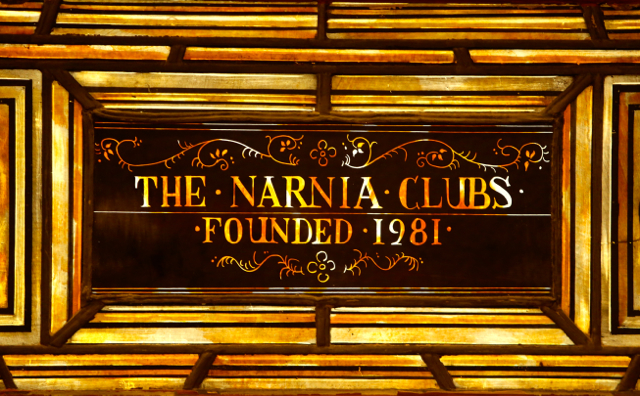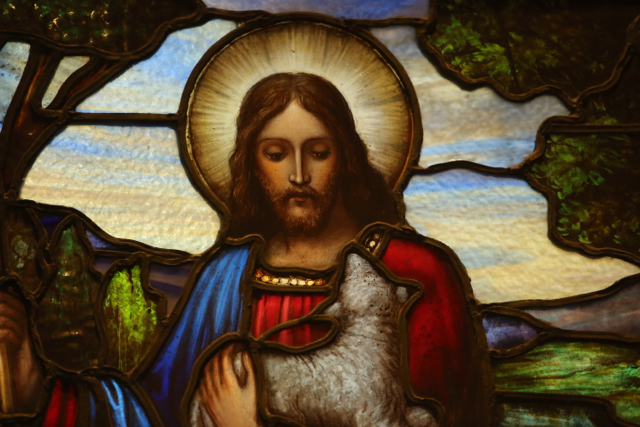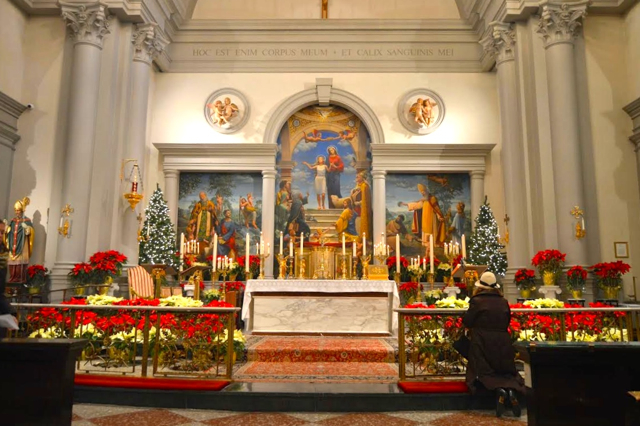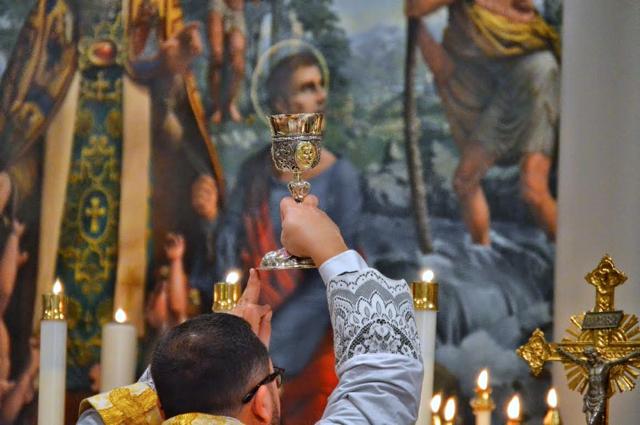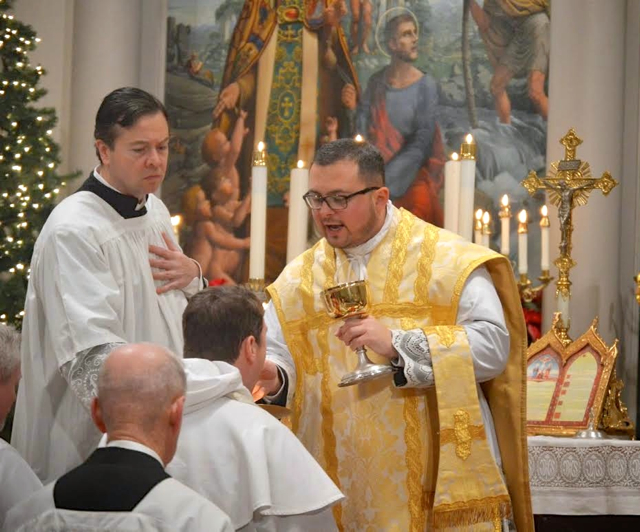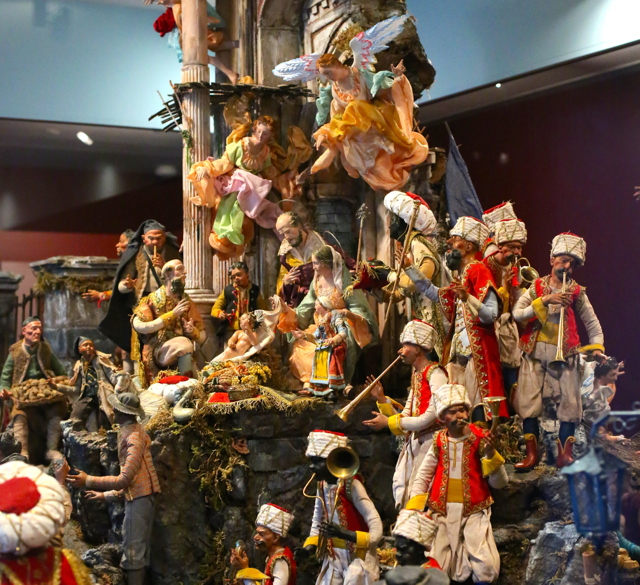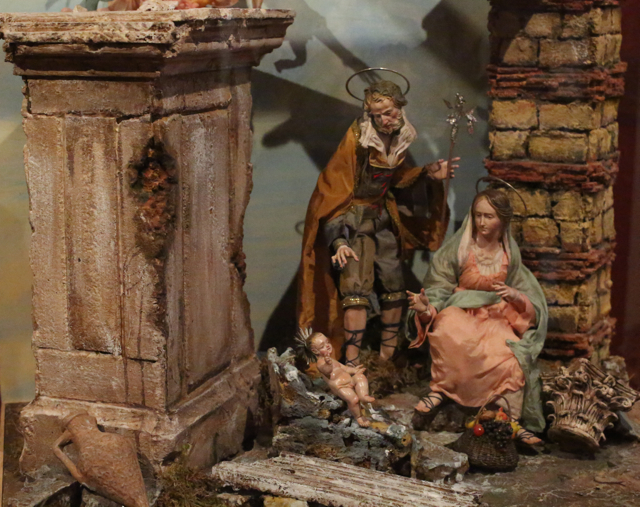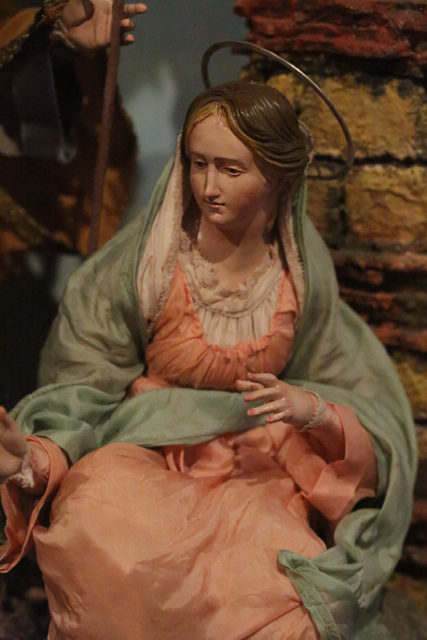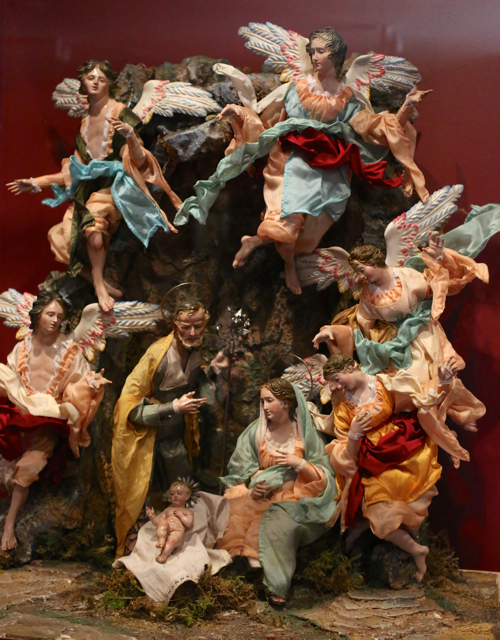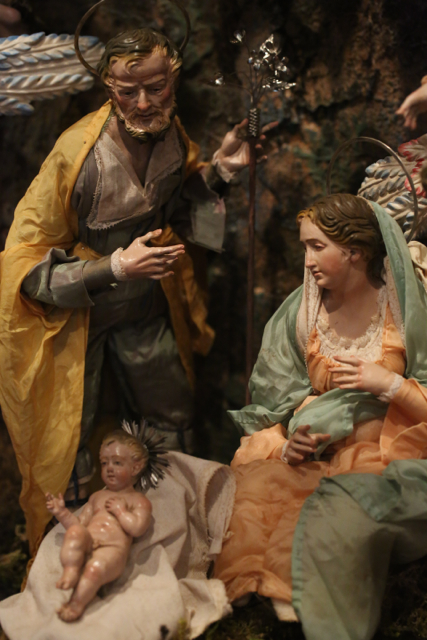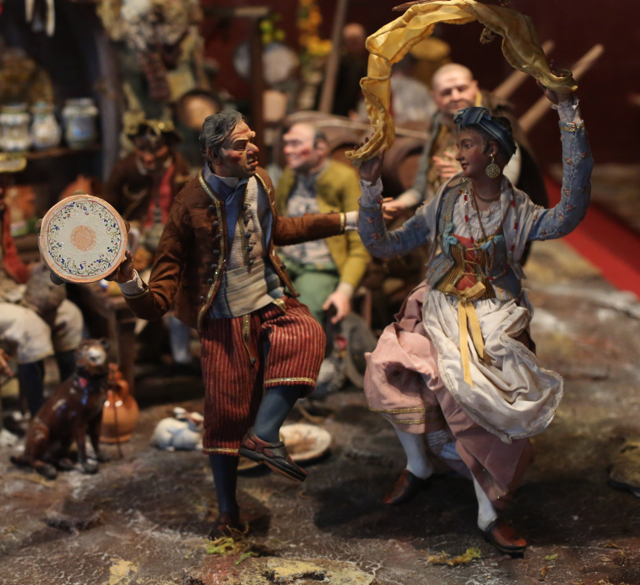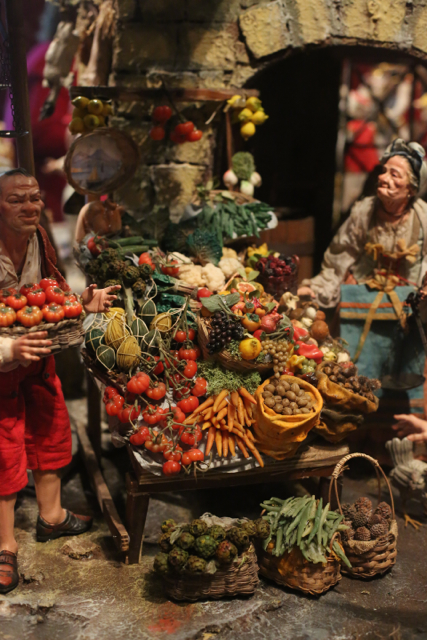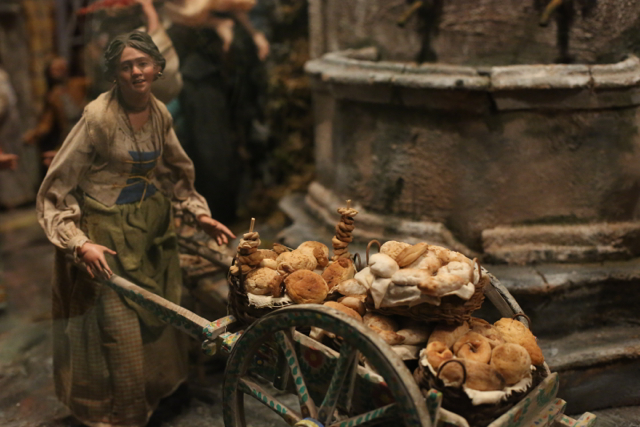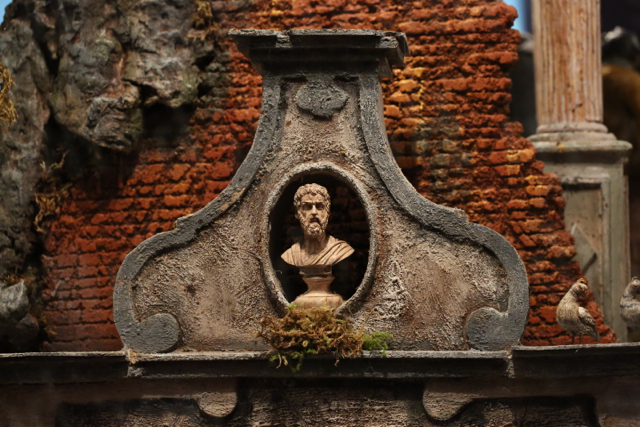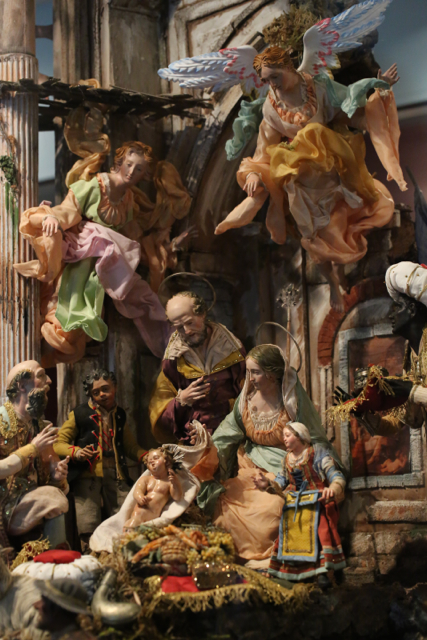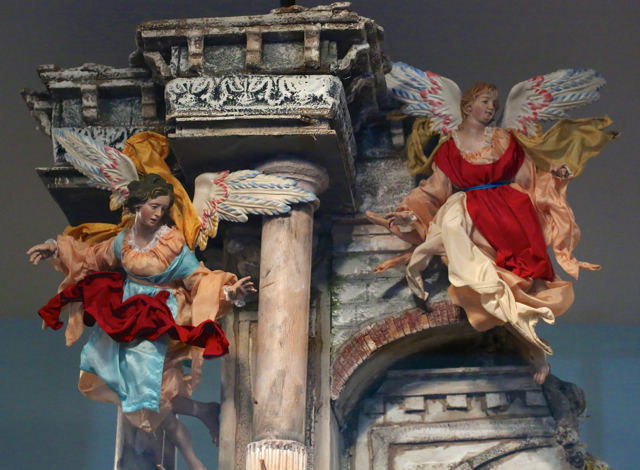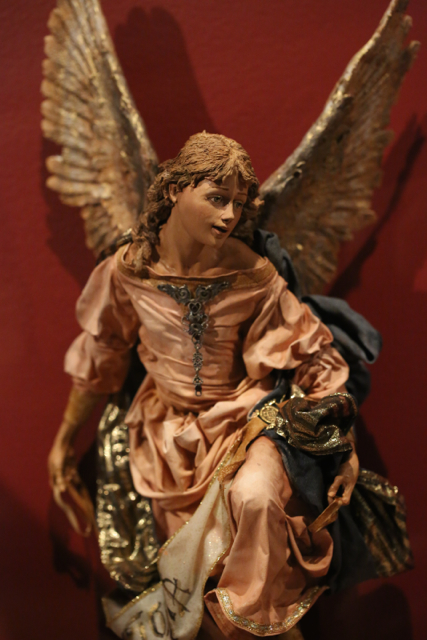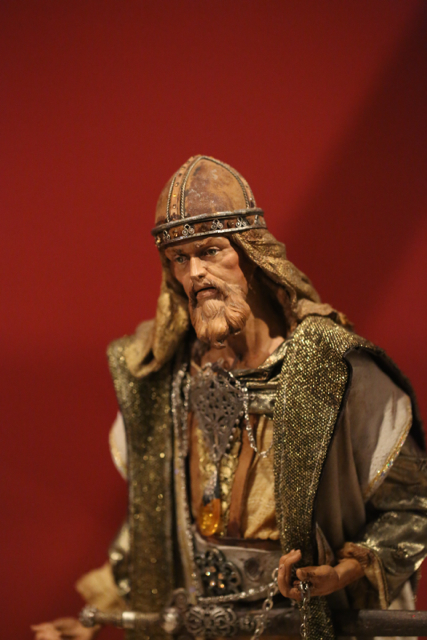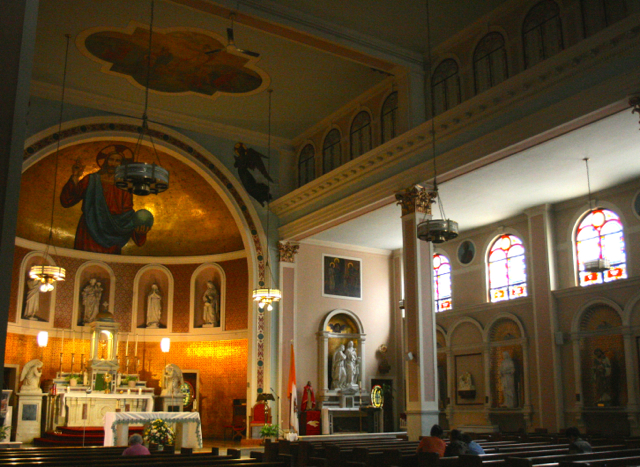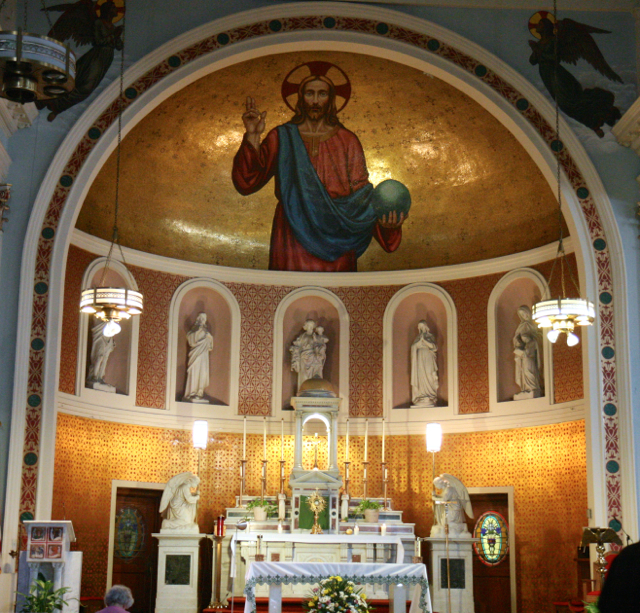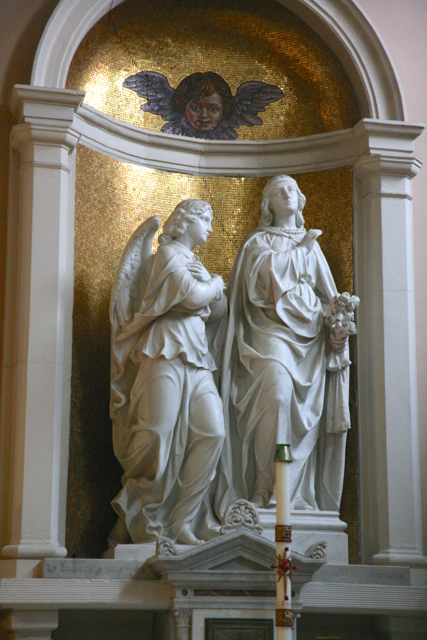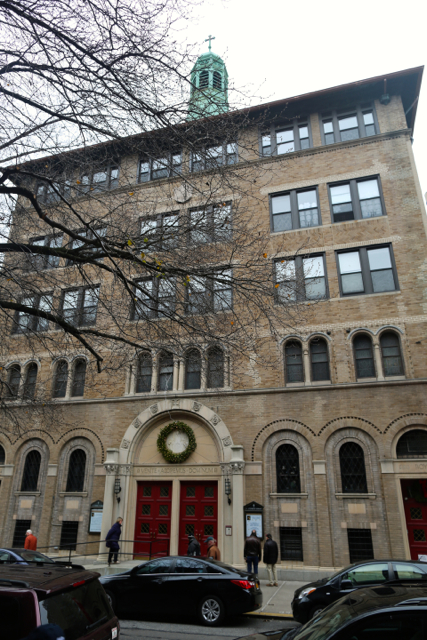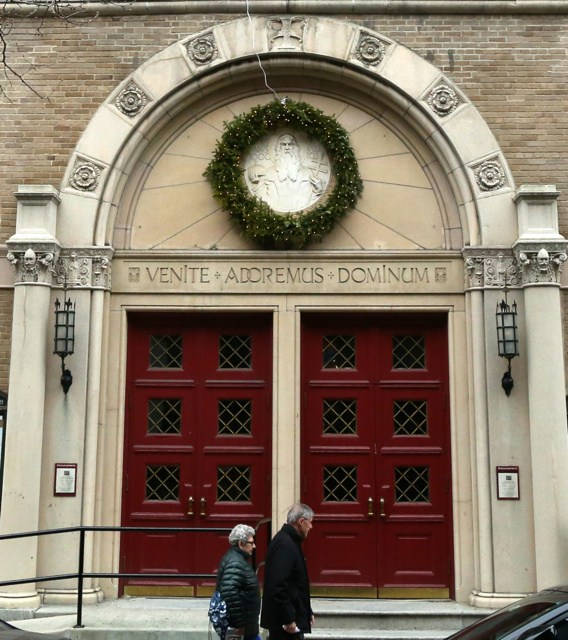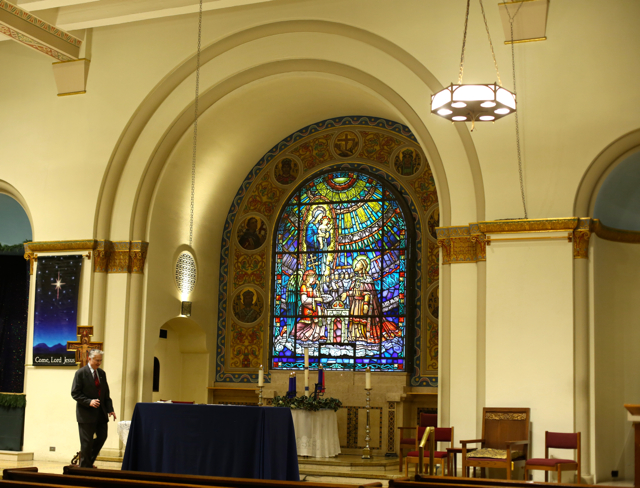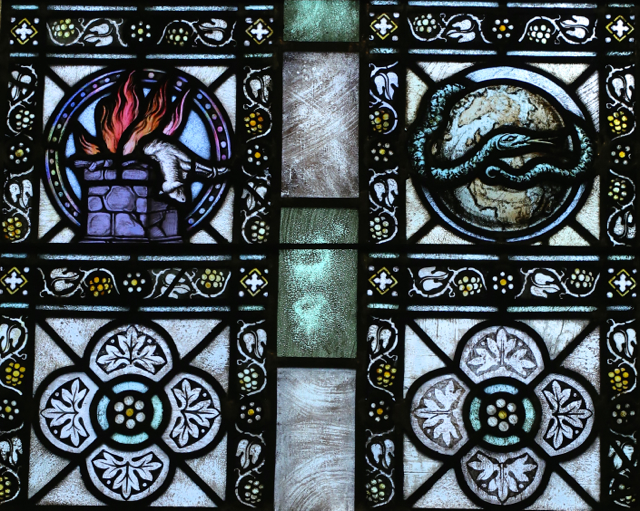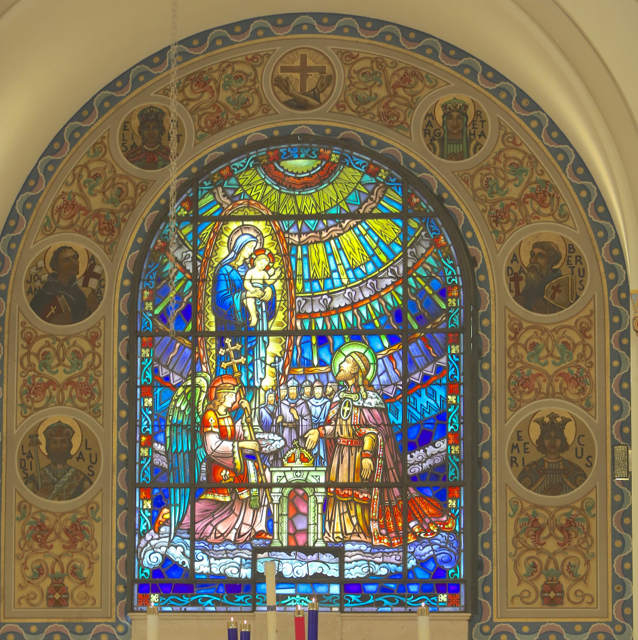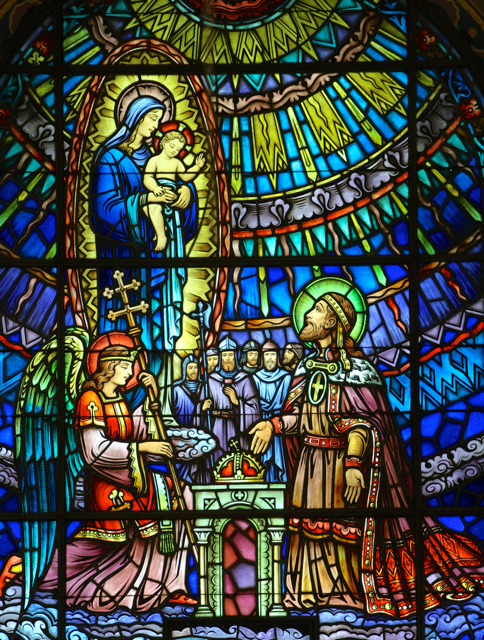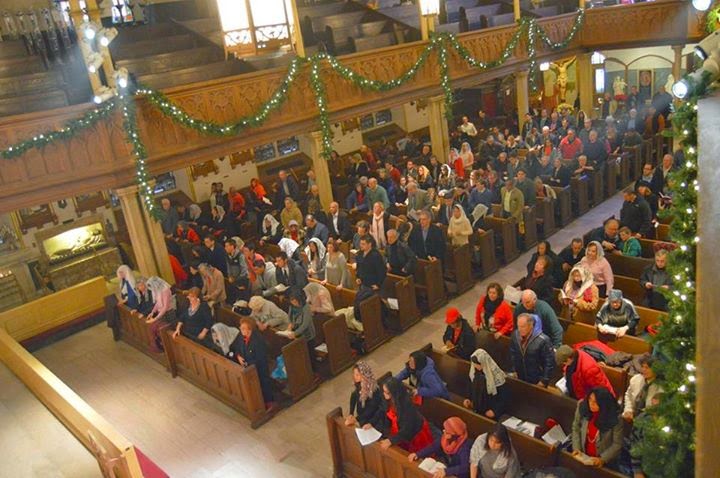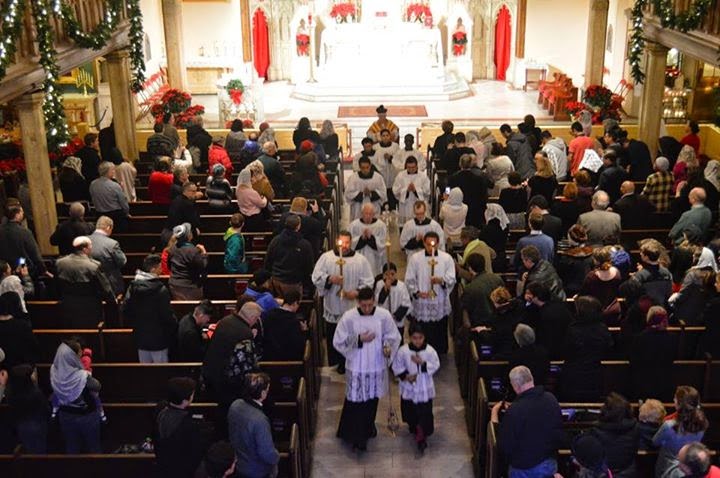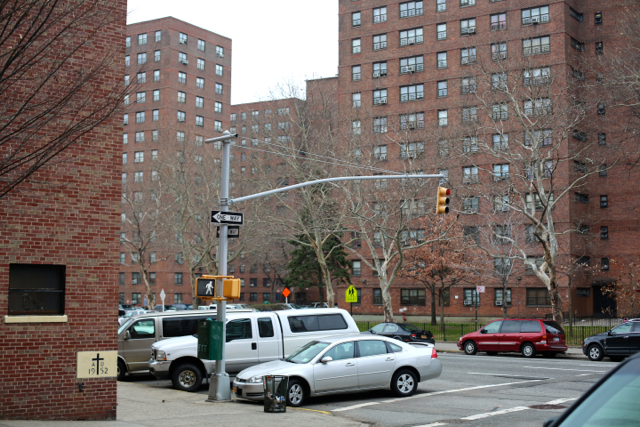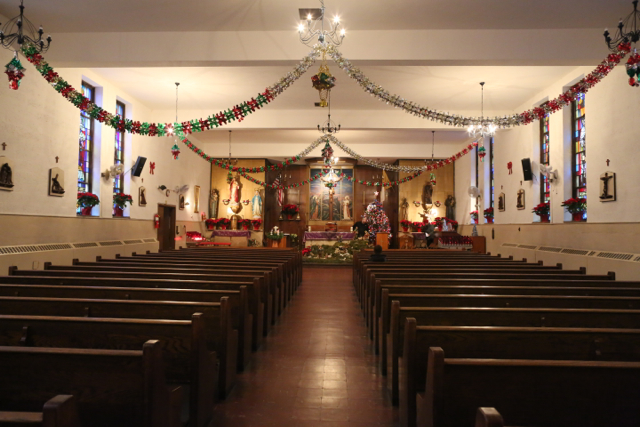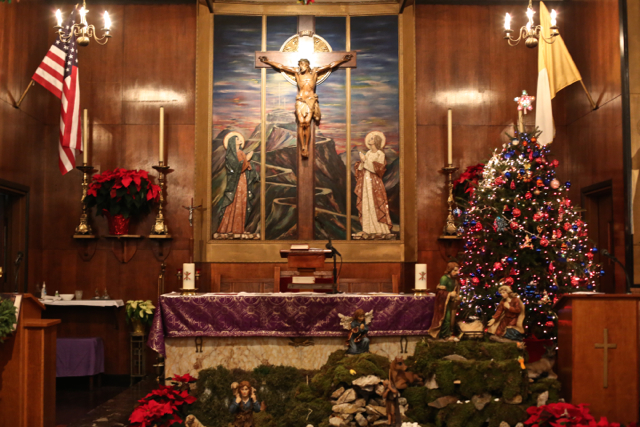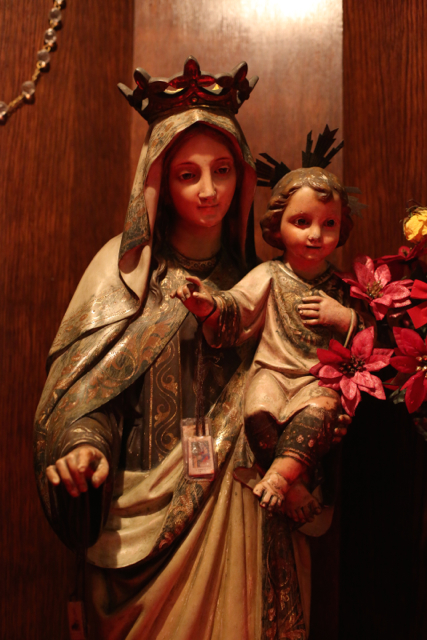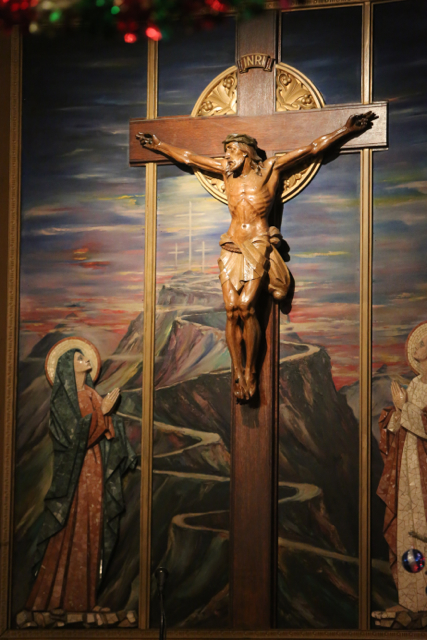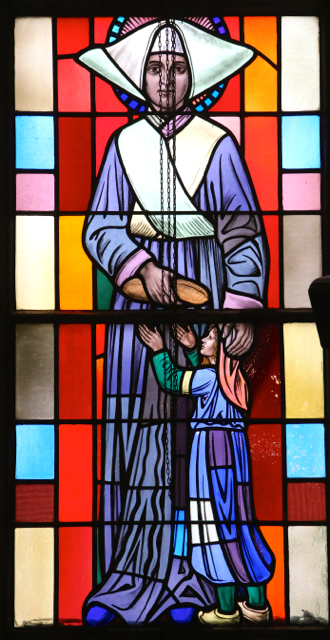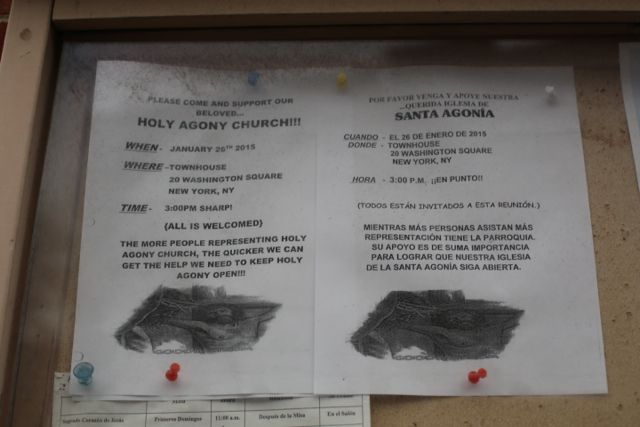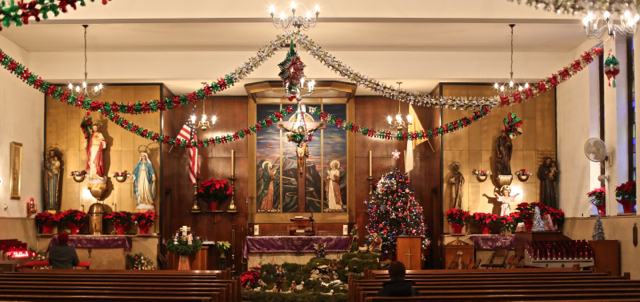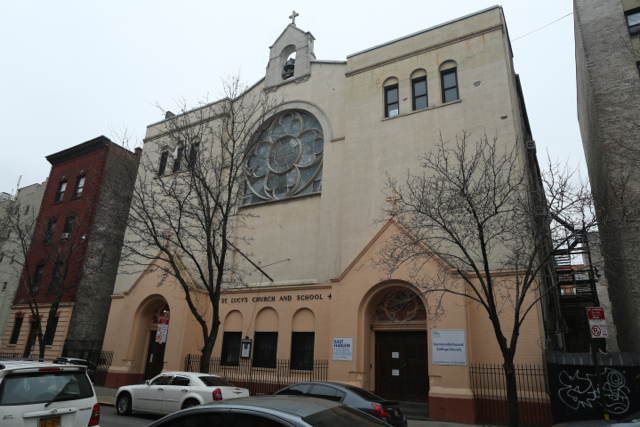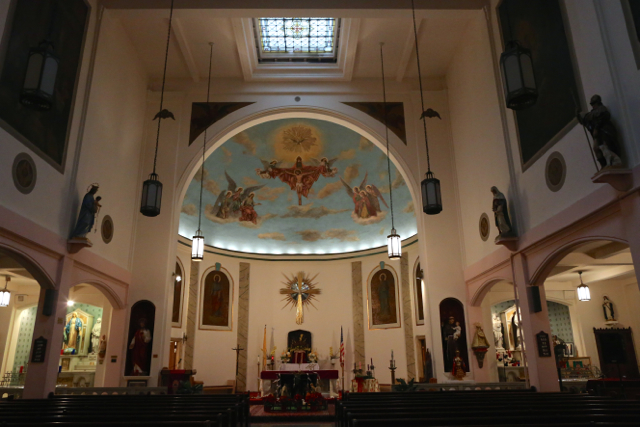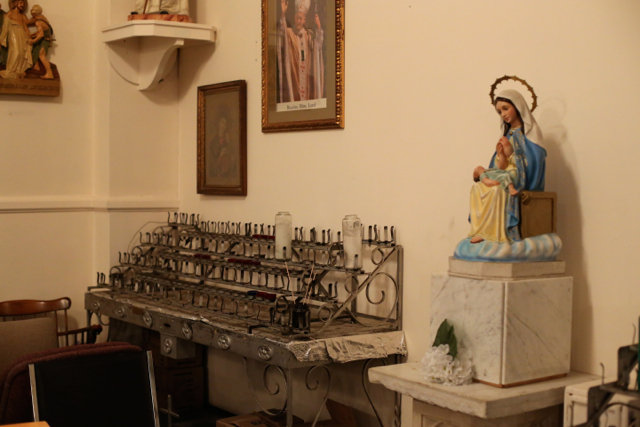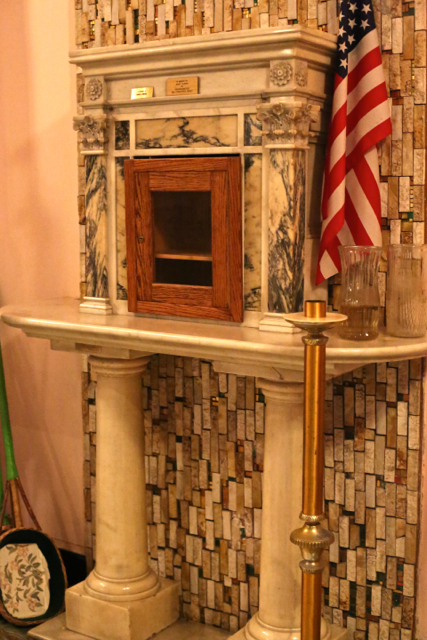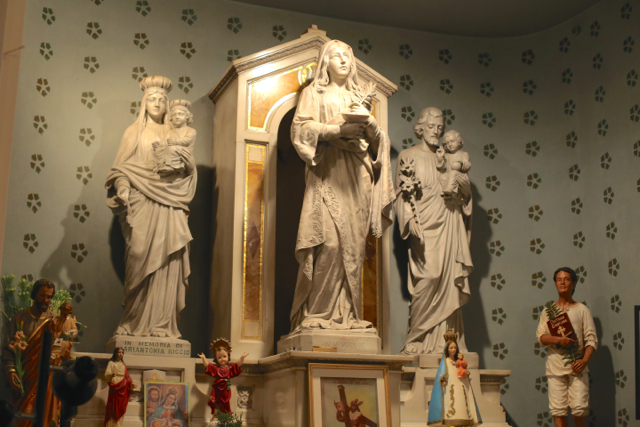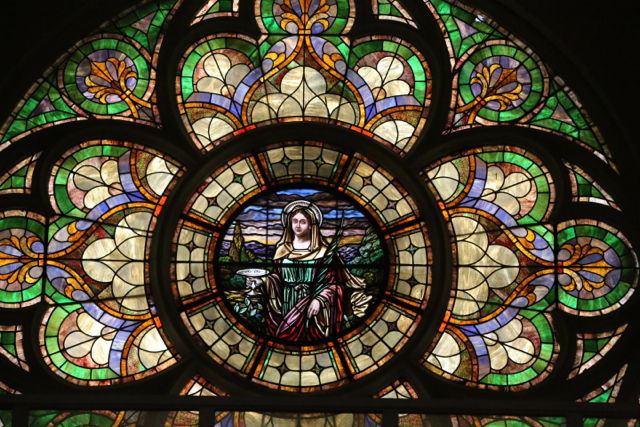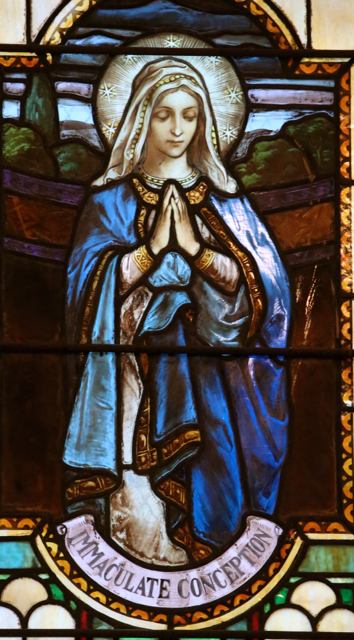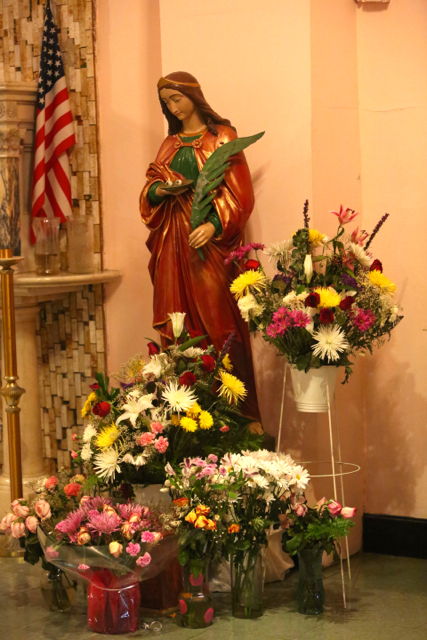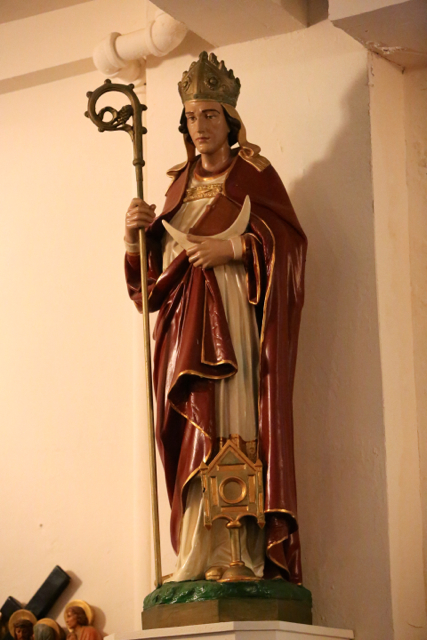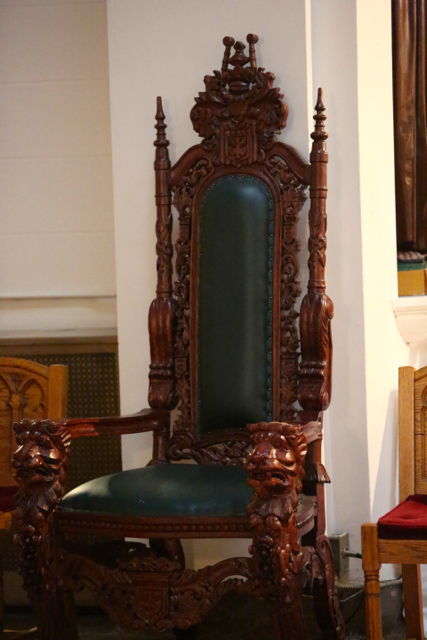Yesterday was celebrated the Patronal Feast of Most Holy Name of Jesus parish, Brooklyn – a Solemn High Mass in their newly renovated church. Some more great photos courtesy of Arrys Ortanez:
5
Jan
4
Jan
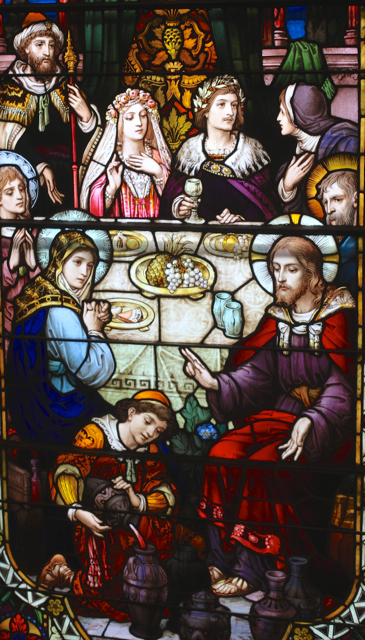
“Three miracles Glorify this day…”
(Window from the Cathedral of St. James, Brooklyn – on the table is a fruit from the New World)
January 6, 2015 Epiphany
Saint Mary Church, 178 Greenwich Ave, Greenwich, Connecticut
7:30 PM Solemn High Mass. The Mass setting will be Missa Sancti Gabrielis by J. Michael Haydn with Gregorian Propers.
St. Mary’s Church, Norwalk, Connecticut
7:00 PM Solemn High Mass
St. Anthony’s Church, 457 Monmouth St., Jersey City,
Missa Cantata, 7 pm. The Three Magi will be stopping by to greet visitors and give candy to the children of the parish at 6:45pm before Mass.
St. Catherine Laboure, Middletown, New Jersey
9:00 AM
Oratory of St. Anthony of Padua, 1360 Pleasant Valley Way, West Orange, New Jersey
9:00 AM; 7:00 PM
Our Lady of Mount Carmel, New York, New York
6:00 PM High Mass, includes blessing and distribution of the chalk.
St. Thomas More
65 East 89th Street
It’s an elegant area indeed around East 90th Street near Park, the so-called “Carnegie Hill.” Even up to the early 1980’s it had the reputation of being a lesser known, less socially prominent but quieter alternative to the Upper East Side to the immediate south. But those days are long past and both areas are for all intents and purposes indistinguishable. Yet overshadowed by the cold luxury of the high rise apartment buildings we find a remarkable sight straight out of the English countryside: a small stone Gothic Church, in the midst of a rambling set of buildings and crowned by a curiously articulated, romantic tower. For good reason we always encounter the same adjectives in articles about this church: ”quaint,” “picturesque,” “quirky,” “charming.” Even if, nowadays, St. Thomas More is dwarfed by the monstrously scaled buildings that surround it and which condemn this delicate little sanctuary to partial perpetual shadow.
There is much history here. St. Thomas More is the second oldest church on the Upper East Side, yet it is also one of the most recent Catholic parishes on the island of Manhattan– for it was not even built as a Catholic church! 1) When this church was built in 1870 it stood isolated near the developing district of Yorkville, far to the north of the built up areas of New York City. It was created by the Episcopal church as the Church of the Beloved Disciple for “St. Luke’s Home for Indigent Women.” As time went on more structures were added: a chapel to the west, a rectory and a parish house to the east, giving the church its present romantic appearance.
In 1925 the Church of the Beloved Disciple merged with another Anglican parish that had migrated from further south in the city. The buildings then were acquired by the Reformed Church of Harlem (which was undoubtedly fleeing south from developments in that area). Which congregation, it is reported, installed eight stained glass windows from their previous church (How was this done? Did their stained glass by chance exactly fit the windows of the Church of the Beloved Disciple or did they have to be cut down?) In the meantime the former Church of the Beloved Disciple, which had been on the far outskirts of the city, now found itself in the northern reaches of the city’s most affluent residential area. 2)
In 1950 Cardinal Spellman acquired this church for the new parish of St. Thomas More. I have heard entertaining tales as to why this was done – usually revolving around rivalry with the Jesuits of St. Ignatius Loyola parish. It is said that the proprietor of a funeral home had had a falling out with Jesuits of St. Ignatius Loyola parish. In revenge he instigated the creation of a new parish to which he could offer his services. Or that Cardinal Spellman himself wanted to break the monopoly of the Jesuits to the Upper East Side (the wealthiest neighborhood of the country, even of the world). More likely, as in the case Our Saviour’s parish erected a few years later, Cardinal Spellman just wanted to give the residents of a well-heeled enclave a neighborhood church of their own. For it was an age where church policy favored the establishment of smaller, more accessible communities in place of the huge (both in terms of the size of the congregation and of the church) parishes of yore.
The dedication of the new parish, St. Thomas More – like that of Our Saviour’s – would be elegant and English. The same held true of the alterations to the interior to convert the church to Catholic worship:
“Inside the church, a marble communion rail was installed at the forward edge of the chancel and shrines to the Blessed Mother and St. Joseph were installed along the left and right sides of the chancel. (A) wooden reredos an(d) angel-topped riddle posts, both displacing (sic) table flower ornaments characteristic of the “Decorated Style,” were also installed.” 3)
(Below) The photograph exaggerates the size of church.
Much of this decoration is still in place. It is all very 1950’s “liturgical movement,” very restrained and very elegant. The white statues of the side altars barely emerge from the wall – no exuberant army of painted images here! It is understandable that only one or two candles – even if real – are lit before such images. A severe post conciliar housecleaning removed, among other things, the communion rail. More recent restoration added a prominent organ in the sanctuary. The overall appearance of the sanctuary today would not offend the sensitivities of the prior Anglican and even Dutch Reformed proprietors of this place.
Nevertheless this small church is a place of contemplation and beauty – entirely attributable to the former Protestant congregations who left a legacy of architecture and stained glass – in the Catholic Style, as Pugin would have said – to the parish. The Gothic arches of the aisles support a wooden hammer beam ceiling. When the lights are dimmed the bright colors of the stained glass glow in the obscurity. These windows constitute the most prominent decorative element of the church. At least the wood of Cardinal Spellman’s reredos does not dispel these impressions.
(Above and below) The “Protestant” Windows.
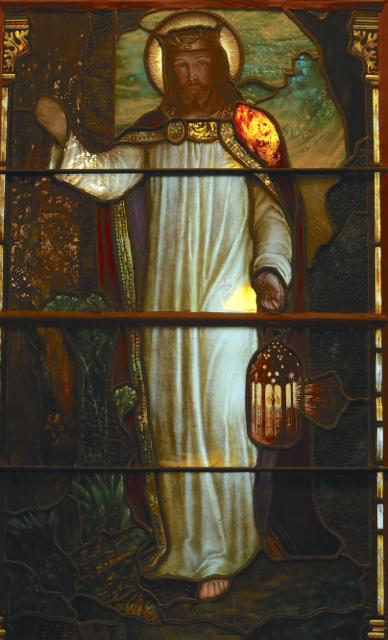
(Above) Victorian favorite: William Holman Hunt’s The Light of the World
The Church of St. Thomas More, both in its interior and exterior, demonstrates how, despite a restricted scale, good architecture can make a profound impression. It is a testimony to the declining state of the arts in the Catholic church of the mid- twentieth century, though, that Cardinal Spellman’s two most successful churches in Manhattan – St. Thomas More and Immaculate Conception – were 19th century structures created by Episcopalians.
And the complex of St. Thomas More is not just the church. There is the 1879 Foley chapel – named after a later donor who funded its refurbishment. It now includes two confessionals. On the other side of church is the grandly scaled rectory (1880) and parish house of 1893. Within is one of the most impressive halls – an “overcroft?” – of any parish in New York City. 4)
(Above) The “Foley” chapel – which at one point was considered a “Lady Chapel.” (Below) After the chapel became Catholic, a window with the coat of arms of the Dutch Reformed church was replced by this window which includes Marian symbols.
After its establishment, St. Thomas More parish quietly carried on in its corner of Manhattan. In the early 80’s it was the scene of some surprising and original lay initiatives. The prior management of the parish were among the few clergy of the day who saw the need to reach out to the “young professionals” (at that time there was a more disparaging term in circulation) of the city. The result was a successful series of social events and Catholic devotions aimed at this population. Similarly, 1981 saw the start of the Narnia club, which even today runs an orthodox catechetical program for the students of non-Catholic schools.
(Above and below) Window with the new “Catholic” dedication of the the Narnia Clubs (see below)
Later, though, thanks to the Kennedy family, this parish found itself in the national celebrity spotlight. When Jacqueline Kennedy – an allegedly “devout” parishioner – died in 1994, the funeral had to be held in St Ignatius Loyola for lack of space at St Thomas More. But when John F Kennedy Jr.’s 1999 service was held in this parish, a blaze of media publicity resulted. The church was reserved to the Kennedy family and their courtiers – not just the church but all of East 89th Street was sealed off from gawkers.5)
So, despite its small scale, St. Thomas More parish seemingly could do little wrong. It was affluent, active and “vibrant.” It was and is in the black. A nursery school was established on the premises of the parish. St. Thomas More parish had carried out a multi-year restoration of the exterior and interior. That included the restoration of the stained glass. In what seemed at least to me to be a controversial choice, the dedications of the original Protestant donors were knocked out and the names of the new donors to the restoration campaign substituted. As we shall see, however, their glory may be short-lived.
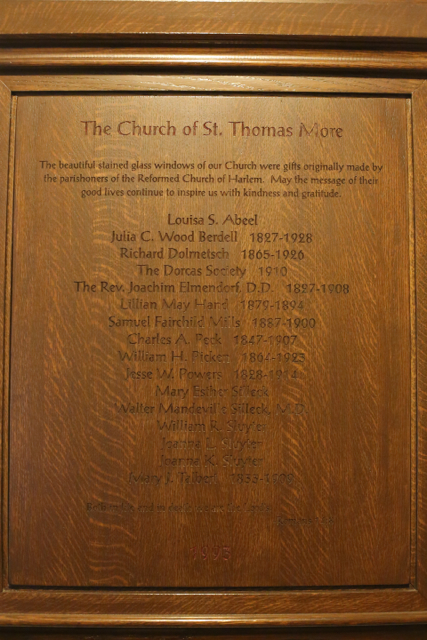
(Above) If you are curious there is a plaque in the small “narthex” listing the original benefactors of the windows.
Yes, at least as far as the churches of Manhattan island are concerned, St. Thomas More appeared to be the ideal Archdiocesan parish. It is characteristic that the o-so-very-progressive court historian of the Archdiocese, (Fr.) Thomas J. Shelley, who wrote effusively about labor unions, class conflict and the civil rights movement, chose to reside for years not at parishes such as Holy Agony, St. Teresa or All Saints (to name three options just in Manhattan), but here.
The news that the Archdiocese intends to close St. Thomas More parish was thus all the more crushing. Especially since the parishioners would be “invited” to attend St. Ignatius Loyola church; after all, St. Thomas More had been founded to sever this neighborhood from St. Ignatius Loyola and its Jesuits! The parish would not seem to have any of the signs of distress identified by the Archdiocese in “Making all things New.” (Whatever one may think of the appropriateness of these exclusively materialistic criteria.) The stated reasons given for this “merger proposal” did not immediately appear convincing: “that since St. Thomas More will eventually close some day, it is better to do it now rather than later, when there is presently a momentum within the Archdiocese to merge parishes.” 6) “I can’t just close poor churches.” 7)
Peggy Noonan, however, has cut to the heart of the matter:
“If St. Thomas More is closed it can be sold. New York is experiencing a real estate boom, Carnegie hill is desirable. The church and its land could bring in $50 million, maybe $100 million. Any number of developers would jump at the chance. It’s rumored –rumored- any number have.” 8)
So St. Thomas More parish now is in the first – and perhaps last – great crisis of its 64-year existence. What a tragedy for the parishioners, the neighborhood and the city as whole to lose such a unique architectural landmark – and reverent place of prayer! Perhaps this is the lesson: even if one – a parish, a diocese or an individual Catholic – leads an economically sheltered life, even if one abides by all the ecclesiastical “rules of the game,” the worsening crisis of the Roman Catholic Church will inevitably overtake him. I wish this parish, which I have known for so many years, well in its campaign for survival. An affluent parish like this does have some powerful and articulate allies. Yet I would also encourage them to reflect on the life of their patron saint – who, after all, also lived – and was martyred – in a time of conflict, confusion and chaos within the Church.
See the informative parish WEBSITE for materials on the proposed closure and on the parish, online petitions etc.
1) Dunlop, David W. From Abyssinian to Zion: A Guide to Manhattan’s Houses of Worship at 247(Columbia University Press, New York, 2004)
2) “History of Our Church” at http://thomasmorechurch.org/history-of-our-church
3) Ibid.
4) Gray, Christopher, Streetscapes: “St. Thomas More Roman Catholic Church; a Touch of the English Countryside in Manhattan, ” the New York Times (4/2/1989)
5) Kleinfeld, N.R., “The Kennedy Memorial: the Service; Doors closed, Kennedys Offer Their Farewells”, The New York Times (7/24/1999)
6) “Fr. Madigan’s Message about Proposed Merger of St. Thomas More with St. Ignatius Loyola November 23, 2014” at http://thomasmorechurch.org/documents/2014/11/Fr._Madigans_Message_about_Proposed_Merger.pdf
7) See Noonan, infra.
8) Noonan, Peggy, “Cardinal, Please Spare this Church,” The Wall Street Journal at A13 (12/27/2014)
3
Jan
High Mass at St. Agnes church for the feasts of Mary, Mother of God, Circumcision and the Octave day of Christmas. Fr. Michael Barone was the celebrant and the Veni Creator Spritus was sung to gain the plenary indulgence granted on that day.
(Courtesy of Arrys Ortanez)
1
Jan
The Creches of Italy
Posted by Stuart ChessmanThe Knights of Columbus Museum in New Haven has made in recent years a valuable contribution to the preservation and dissemination of the Catholic art of the Christmas season. The latest in their series of exhibits of Christmas creches deals with Italy – where the tradition was created by St Francis of Assisi and where it reached its most elaborate form.
The focus of this exhibit is on the manger scenes of Naples – the most elaborate of all. Above, the Holy Family amidst the ruins of the pagan world.
Most of the Neapolitan exhibits come from the firm of Bottega D’Arte Presepiale Cantone & Costabile, Naples, which works in the style of the 18th century. Antonio Cantone and his firm created the main creche on exhibit (photo at the beginning of this article)in about a year of work. He has a more ancient, even medieval, understanding of his work as an artist: “I am using art to express my religion.”
(Above and below) At its most elaborate the Neapolitan creche places the coming of Christ in a minute depiction of the world of the everyday life the people: their occupations, their pleasures, their food and their different social classes. As the Byzantine rite proclaims:”Christ is in our midst!”
The exuberance, naturalism and symbolic content of Baroque art – the last great manifestation of Christian art to succeed in shaping an entire culture and which survives even in our day in the Neapolitan creche- – seems at times to have perplexed whoever wrote the otherwise informative notes to this exhibit. We find there references to a supposed tension between the elaborate creche scenes and the simplicity of the Holy Family; the scenes of the people are supposedly not representative of the misery of the people of that time. As if that were the purpose of these figures! Ancient ruins are depicted in manger scenes, according to this source, because they lay about everywhere in Campania and, moreover, the 18th century craze for Pompeii and its art was getting underway.
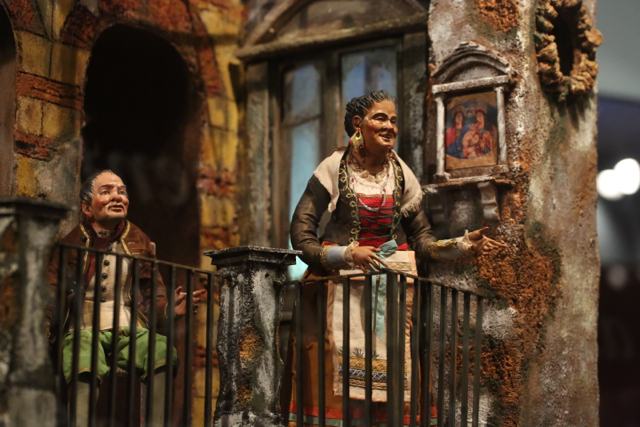
(Above) The innkeepers who excluded the Holy Family (including an 18th century holy image on the wall!). (Below) Once again the theme of the supersession of the ancient pagan world by the coming of Christ.
(Above and below) In contrast to the preceding genre scenes is the outpouring of the Divine encountered in the presence of the Holy Family and angels.
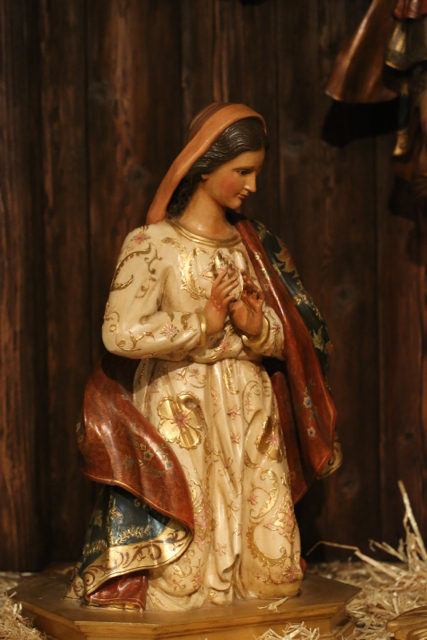
(Above) the Museum also is showed a selection of creches from other regions and cultures that take up the baroque theme. Here is a life size figure carved by Agustin Parra in Guadalajara, Mexico
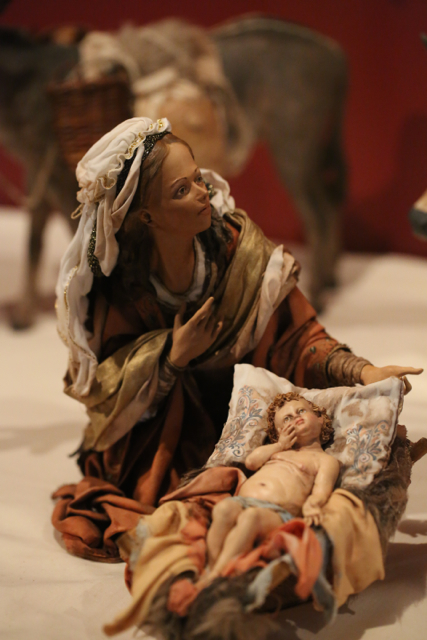
(Above and below) Figures from a Nativity scene created by a Sicilian artist.
An exhibit at the Knights of Columbus Museum – 1 State Street, New Haven, Connecticut. Now throughout February 1! See HERE for further information and directions.
For the Firm of Arte Presepiale Cantone et Costabile see HERE.
29
Dec
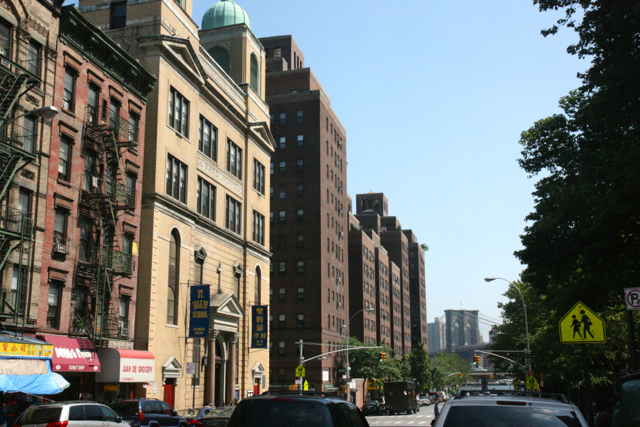
The church of St. Joseph with the Brooklyn Bridge in the background.
St. Joseph’s (St. James and St. Joseph)
5 Monroe Street
The high façade of St Joseph’s – San Giuseppe – enjoys a rare unobstructed site overlooking the Lower East Side. Not too far away stands the Brooklyn Bridge, surrounded by its entrance ramps. This is a changing area indeed: in part being absorbed into Chinatown, in part experiencing transformation into entertainment and even upscale residential areas.
Built in 1924 as an Italian national parish, St. Joseph’s has been directed from its beginnings by the Missionary fathers of St. Charles Borromeo (the Scalabrini Fathers). The school opened shortly thereafter – in 1926. Like other smaller parishes in New York, St. Joseph’s building houses a combined church and school.
In 1967 St. Joseph’s absorbed the activities of the Parish of St. Joachim, another Italian national parish directed by the Scalabrinians, when that church had been demolished for a housing project. In recent years the congregation of this parish has become increasingly Chinese. A few years ago the St. Joseph’s merged with (really, took over) the ancient parish of St. James located to the south. 1) The parish school merged with that of St. James parish in 2010; in 2013 the combined school closed. So rapid is the decline! (Transfiguration parish school has taken over the building of St. James)
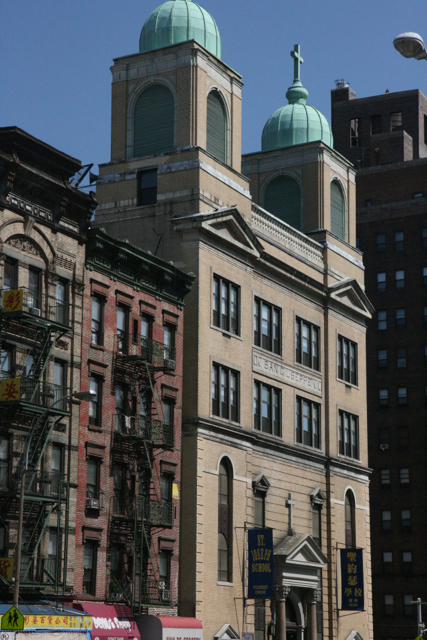
“San Giuseppe” – when this picture was taken still with its school.
I do not know much about the parish of St. Joseph, located as it is in an out-of-the-way corner of the city. With its two towers and elaborate classical details, St. Joseph’s appearance is much more church-like than that most of its sister parishes sharing a similar, institutional layout. Its façade even bears a certain resemblance to that of Our Lady of Pompeii – built at the same time and also directed by the Scalabrini Fathers. The interior is simple, and, although colorful, is decorated in an infinitely less lavish style than that of its sister in the Village. The quality of the murals, statues and other decoration is very variable: while some statues are very fine, other elements verge on folk art. As might be expected of an Italian parish, we encounter a seemingly limitless number of statues – here, rather unusually, situated in niches along the walls. Their gold background picks up the theme of the vaguely Byzantine apse.
Now, despite having a claimed Sunday mass attendance of 600-700, San Giuseppe is scheduled for closure. The congregation is to be merged with nearby Transfiguration parish – also predominantly Chinese but rather small. 2) We will see how that works out in practice.
The real catastrophe, however, would be the loss of St. James church – one of the most historic Catholic churches in Manhattan and alsoone of the most aesthetically pleasing. The Order of Hibernians intervened once before to prevent the closure of this church and to finance a beautiful restoration. Will the same occur now? After all, St. James – the parish of Al Smith – is of infinitely stronger importance to the Irish experience in America than St. Brigid’s over which such a struggle was recently waged. For St. James parish, see “Faith of Our Fathers.”
1) http://www.nycago.org/Organs/NYC/html/StJosephRCLES.html
2) Arino, Lisha, Catholic Church’s Closure Stuns Lower East Side Parishioners (DNA Info/ East Village and Lower East Side 11/04/2014)
29
Dec
St. Stephen of Hungary
414 East 82nd Street
With St. Stephen of Hungary we depart from “Spanish Harlem” and enter old Yorkville or, nowadays, the gentrified “Upper East Side.” A neighborhood that as recently as the early 1980’s contained a treasure trove of German, Hungarian, Czech and Slovak churches, shops and restaurants – although even by that decade most of the old time residents had left. Now, except for one or two restaurants, only the churches survive.
St. Stephen of Hungary parish began in 1902 in the basement of the (still-existing) St. Stanislaus church. In 1905 it acquired a former Protestant church of East 14th street. By 1914 the congregation numbered 4000 Hungarians. Like the Slovak congregations of St. John Nepomucene and St Elizabeth of Hungary – Slovakia then being part of Hungary – the parish subsequently migrated to Yorkville. A new church was begun in 1927 and completed in 1928. Like the churches of St. Lucy or Corpus Christi, it was a combination school, church and community center. In 1922 the Franciscans had taken over direction of the parish. The consecration of the church in 1928 by Cardinal Hayes was an important Hungarian national manifestation – over 10,000 were in attendance.
From that time forward St Stephen soldiered on as an important center of Hungarian culture and religious life in New York. But already by the 1940’s the congregation was an increasingly composed of non-Hungarians (predominantly Irish-American) – the girls’ choir of the school won awards in that decade for singing in English and Gaelic! Certainly the pastors since that time were also mainly Irish. Further waves of immigration after the Second World War did reinforce the Hungarian element, and St Stephen’s remained a focal point of Hungarian culture. In 1974 the heroic Cardinal Mindszenty celebrated mass here one year before his death. 1)
Despite all this, the number of Hungarian speakers dwindled further even as the average income within the bounds of the parish drastically increased. According to the parish website only one mass on Sunday is now n Hungarian (although my personal experience of just week ago suggests that this is not entirely accurate.2)
By 2009 Stephen’s parochial school was in crisis with just 150 students. It attracted considerable favorable media attention by 2012 with its alleged success repositioning itself to cater to the educational needs of the current (affluent) inhabitants of the neighborhood of St. Stephen’s. Basically the school was trying to break with what had become the predominant model for the parochial schools of Manhattan: basically, the providing of poor relief. The entire discussion, conducted in completely secular terms, reveals how deeply eroded the mission of this parochial school – originally national and religious – had become. It also reveals the inability of the parish and school to adapt to changes in the neighborhood – a problem shared by many other parishes and by the Archdiocese as a whole. 3)
The façade of St Stephen’s is more that of a school than of a church. Yet the effect, with its Romanesque revival decoration and “Boys”” and “Girls'” entrances, is nevertheless very pleasing. So is the church – as in all such church/ school complexes, basically an auditorium. That of St. Stephen’s is much more spartanly decorated than most – has the strong influence of the Hungarian reformation penetrated even here and overcome the national baroque traditions? Upon closer examination the sparse decorative elements – like the non-figurative glass with a host of sometimes enigmatic symbols- are attractive in their way. A drastic conciliar “updating”of the sanctuary has not helped. But all is maintained in very fine condition.
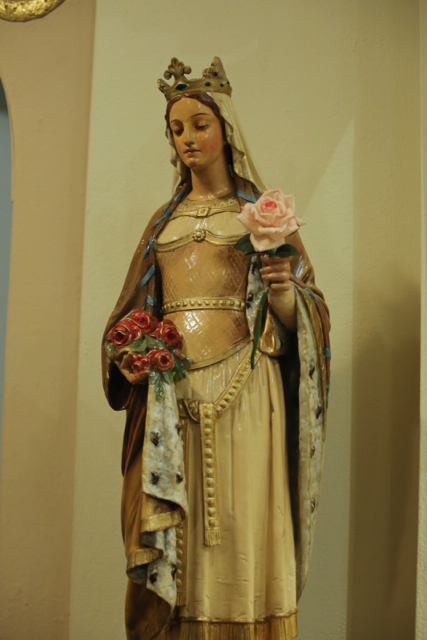
(Above) St. Elizabeth of Hungary
Finally, the dominant artwork in the church is a large stained glass window of St Stephen in the sanctuary. St. Stephen, who converted Hungary to Christianity, places the crown of Hungary before God and at the foot of the Madonna – the window also is surrounded by images of the saints of Hungary. Is it not strange? – if the Archdiocese has its way, within just a couple of years the churches of St Stephen of Hungary, St Elizabeth of Hungary and St Emeric – all the parishes in Manhattan dedicated to saints of Hungarian origin – will have been shuttered. The saints of these churches testify to an age where not just individuals but an entire nation could be consecrated publicly to Christ. That created a bond that survived the many vicissitudes of the Hungarian nation: the Mongols, the Turks, the First World War, the Soviets…. It is why thinkers like Thomas Molnar could never accept the liberal ideology of the separation of church and state. In our time we have seen the last gasps of that dying era, the age of Christendom.
St Stephen of Hungary parish is now scheduled to close. A pall hangs over the parish. The fate of the school is uncertain. Here in New York, the closing and sale of so many churches accompanying the retreat of the Church into a private suburban cult witness to a “new age” antithetical to that of Christendom. Can we nevertheless turn to the founders of the now-vanished age of Christendom – like St Stephen – for guidance in navigating the new era of established unbelief?
1) See generally: St. Stephen of Hungary Parish New York City 1902 – 2002 (St Stephen of Hungary Church, New York, NY, 1979 (sic)); http://www.nycago.org/organs/nyc/html/StStephenHungary.html;
http://en.wikipedia.org/wiki/St._Stephen_of_Hungary_Church_(New_York_City).
2) http://www.ssh-nyc.org/worship/schedule.html
3) Anderson, Jenny, To Survive, a Catholic School Retools for a Wealthier Market (The New York Times, 8/19/2012; Curanaj, Linda, Struggling Catholic School turns things Around (MYFOX.COM 9/07/2012; 9/11/2012)
29
Dec
Eddy Toribio reports on the 10:30 AM Mass yesterday:
“Three hundred and twenty (320) faithful attended this splendid Mass at this very active and vibrant church. Many of them prayed one Our Father and one Creed, as well the prayers required for the intentions of the Holy Father in order to gain the plenary indulgence (under the usual conditions of the Church).
In his sermon, Fr. Villa encouraged devotion to the Sacred Heart and to the Immaculate Heart. He also asked for prayers for Priests and greater reverence devotion to the Eucharist, as well as the daily recitation of the holy Rosary, all of which will, naturally, lead to a greater use of the Sacrament of Confession and the other Sacraments.”
(Photo Courtesy of Arrys Ortanez)
28
Dec
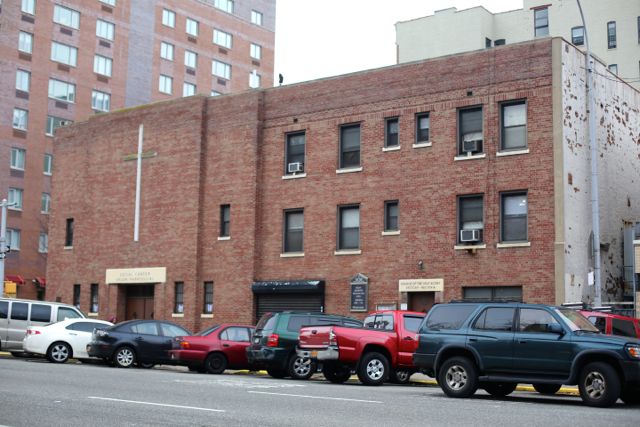
The complex of the church of the Holy Agony seen from Third Avenue.
Church of the Holy Agony
1834 Third Avenue at 101st Street
Just a short walk away from St. Lucy’s is the church of the Holy Agony. It was founded in 1950 as a mission of the Church of Our Lady of the Miraculous Medal – itself established in as one of the early Hispanic parishes in New York. Cardinal Spellman built the current church in 1952 primarily for the then – burgeoning Puerto Rican population of the area. Now Our Lady of the Miraculous Medal closed in the 1980’s – but Holy Agony parish has continued to the present day. Like its founding parish, Holy Agony always has been directed (I believe) by the Vincentians. 1)
Like the neighborhood around St. Lucy’s, the surroundings of Holy Agony – housing developments – are cold and depressing. Yet in the immediate vicinity of the parish are also signs of gentrification. Am I mistaken in seeing in this one reason that Holy Agony church is scheduled to be closed?
This church, occupying a corner lot, presents an austere, institutional face to the world both on Third Avenue and on East 101st Street. In this it is similar to the (now closed) church of St. Emeric near Stuyvesant town. But it also corresponds to the growing adoption of a stripped-down, “moderne” style, especially in the suburbs, as the Spellman era progressed. And even if it does not exactly look like a church, these facades with their red brick walls and white facings are light years removed from 1970’s – era junk like the current church of Nativity parish.
(Above)The entrance to the church;(below) the view across Third from the church (extreme left).
Inside, we find basically a long spacious auditorium. Yet all seems solidly built and tastefully decorated. In contrast to the disorder of St. Lucy’s, all has been maintained in in extremely fine condition as well. Yet it’s clear that the quality of individual items of the decoration – like the stained glass or statues – had drastically declined since the 1920’s. Only a few statues seem to have wandered in from another church.
We have little to report on the history of the parish – other than a debate a couple of decades ago on changing devotions as the population shifted from being entirely Puerto Rican to representing a much broader group of “Hispanic” peoples.2)
The English language Sunday liturgy shows the strengths and weaknesses of this parish. An elderly priest “presided” over a much younger congregation. Uniquely, little children acted as ushers. The director of these ushers and the celebrating priest were the only men involved in the entire ceremony. Everyone else – the “acolyte,” the lectors, the leader of the choir and the singers – was female.(even though men were well represented in the congregation). But the sermon was solid and the closing remarks of the pastor even better. The two things I dislike about Christmas in this country, said he, are “Happy Holidays!” and Santa Claus. It’s a sermon that should be given at every Catholic church.
It looks like Holy Agony parish – which appears to be active and “vibrant” – does not agree at all with the decision of the Archbishop to shut down their church in “Making all things New. ” They have reached out to various media. 3) I wish them luck in their uphill struggle! For it is hard to rally the necessary outside support for a small Hispanic parish that has carried on valiantly for so many decades under such trying conditions.
1) http://en.wikipedia.org/wiki/Church_of_the_Holy_Agony_(New_York_City)
2) Gonzalez, Juan, Cultures Clash at Church in el Barrio (New York Daily News, 1/10/1997)
3) Otterman, Sharon, Heartache for New York’s Catholics as Church Closings are Announced (The New York Times, 11/2/2014)
28
Dec
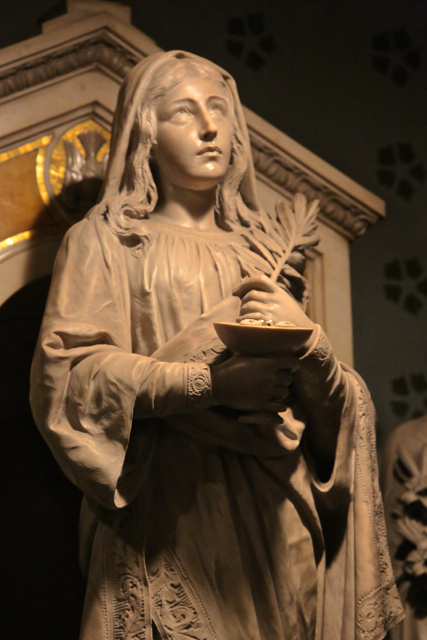
St. Lucy (from the original high altar?
St. Lucy
344 East 104th Street
Four smaller, lesser-known parishes, each originally founded as a mission to a specific nationality. Four parishes that from their beginnings to the present day have more or less retained the status of an ethnic parish (but not necessarily of the same ethnicity!). And four parishes slated for elimination by August 2015 under “Making all Things New. “ Let’s undertake a tour of these more obscure churches of New York – and discover for ourselves the terrible cost of the current downsizing even where it occurs out of the limelight, off the beaten track….
St. Lucy’s parish is situated in one of the most forbidding streetscapes of any Catholic parish in New York. Round about are the monuments of decades of unsuccessful state beneficence: housing complexes, schools etc. We regret to inform you that the Archdiocese and local parishes played a role in the creation of some of these structures. Only an old neo-Gothic public school building strikes a friendlier note. In the midst of these ruins is the pathetic little parish of St. Lucy. Its austere, unadorned and somewhat crude façade dates to a time where the neighborhood may have been poor yet the architecture still retained a human scale.
St. Lucy’s parish was founded in 1899 to serve both Italian and English-speaking Catholics. In 1901, when the first basement church was completed, the parish population was 5000-6000 of which half were Italian. By 1914 the population had grown to 15,000-16,000 of whom all but 500 were Italian speaking. So although this parish originally had a dual mission, within 15 years it had become almost exclusively Italian. 1)
In 1914 the new parish complex was begun. Both church and school opened the following year. Like a number of other parishes built in Manhattan between 1900 and 1940 – Corpus Christi is the most famous example – the new St. Lucy’s is a combined church and school. Decoration in the form of a rose window, a small bell-tower and Gothic gables over the entrance doors enhances the plain institutional structure. After entering the building, one has to ascend a flight of stairs to reach the church itself. 2) For some reason, Cardinal Spellman dedicated the “new” school only in 1942. Is recorded that he was the only participant in the ceremony who did not speak in Italian. 3)
Since then little was heard from St. Lucy’s outside its immediate neighborhood. The once exclusively Italian parish became “Hispanic “ – probably Puerto Rican. Its school merged with that of St. Francis de Sales in 1993 – and then was closed in 2004. (St. Francis de Sales school also closed in 2007 after a series of tumultuous clashes over its direction and a 50% drop in attendance between 2004 and 2007.) In 1998 St. Lucy’s was also put under the administration of St. Francis de Sales parish. 4) In 2001, when Cardinal Egan celebrated a renovation of the church in a service conducted in English and Spanish, St. Lucy’s had only 300 parishioners. Yet at that time Cardinal Egan praised the beauty of the windows statues and altars of St. Lucy’s, the alleged success of its newly combined school was widely acknowledged… 5)
The interior of the church of St. Lucy’s presents a sorrowful appearance of neglect. Like all such combined church/schools it is really just a glorified auditorium to which an apse, side aisles and skylights have been added and to which statues, windows and paintings have been applied. Truly the quality of most of the decoration shows that this parish never was wealthy!
All about us today are the signs of neglect. The rear and side aisles of the church are used as storage space for all kinds of things: musical instruments, chairs and just plain junk. Battered, unused stands for votive lights are spread about. What looks like the original tabernacle is attached to the back wall and serves as a repository for holy oils. The sanctuary underwent a drastic conciliar “restoration” creating a space of much more than usual ugliness. Catholic New York records that the 2001 “renovation” was intended to correct that to the extent possible. The image of St Lucy – once on the main altar of the church – was brought to the front of the church again – I assume this is the statue on one of the two very fine side altars.6)
And yet – all about there are small groups of parishioners devotedly setting up elaborate floral displays here and there throughout the church. This ministry of flowers appears to be uniquely Hispanic – one sees the same at other parishes like St. Veronica. Like all Hispanic parishes – and Italian one as well – the number of statues and devotions seems unlimited. And some of the individual statues and stained glass are quite lovely.
St. Lucy’s was indeed never well-off from the very beginning. And the problems of this parish, aside from those ever-present financial constraints, obviously started decades ago.The high crime rate in the immediate vicinity, the ravages of the Vatican Council and the vicissitudes of the parochial school system left terrible scars. Yet the fall-off since 2001 has been precipitous and appalling. Will we ever honestly inquire what has happened to New York Catholicism in that time?
(Above, an unusual, unidentified saint. Below, a unique “presider’s chair” in the conciliar sanctuary)
1) The Catholic Church in the United States of America, Volume 3 at 344(Catholic Editing Company, New York 1914)
2) http://en.wikipedia.org/wiki/St._Lucy’s_Church_(Manhattan) (with many pictures)
3) Martin, Julia, St. Lucy’s at 100 (Catholic New York, 1/18/2001)
4) Gonzalez, David, In East Harlem School Closing, Talk of a Class Divide (The New York Times, 4/10/2007)
5) Martin, op. cit.
6) Martin, op. cit.
Contact us
Register
- Registration is easy: send an e-mail to contact@sthughofcluny.org.
In addition to your e-mail address, you
may include your mailing addresss
and telephone number. We will add you
to the Society's contact list.
Search
Categories
- 2011 Conference on Summorum Pontifcum (5)
- Book Reviews (95)
- Catholic Traditionalism in the United States (24)
- Chartres pIlgrimage (17)
- Essays (176)
- Events (669)
- Film Review (7)
- Making all Things New (44)
- Martin Mosebach (34)
- Masses (1,338)
- Mr. Screwtape (46)
- Obituaries (14)
- On the Trail of the Holy Roman Empire (22)
- Photos (347)
- Pilgrimage Summorum Pontificum 2021 (7)
- Pilgrimage Summorum Pontificum 2022 (6)
- Pilgrimage Summorum Pontificum 2023 (4)
- Sermons (79)
- St. Mary's Holy Week 2019 (10)
- St. Mary's Holy Week 2022 (7)
- St. Mary's Holy Week 2023 (7)
- St. Mary's Holy Week 2024 (6)
- Summorum Pontificum Pilgrimage 2024 (2)
- The Churches of New York (198)
- Traditionis Custodes (49)
- Uncategorized (1,369)
- Website Highlights (15)
Churches of New York
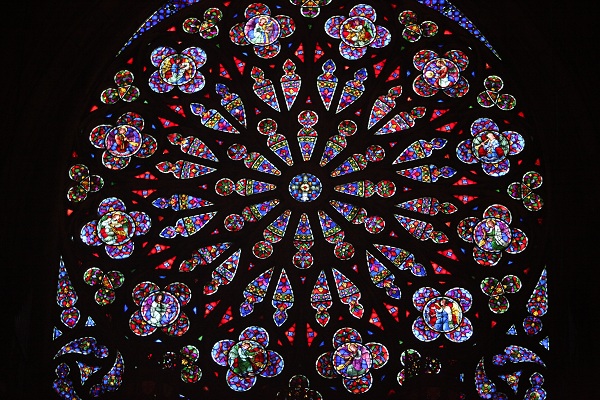
Holy Roman Empire
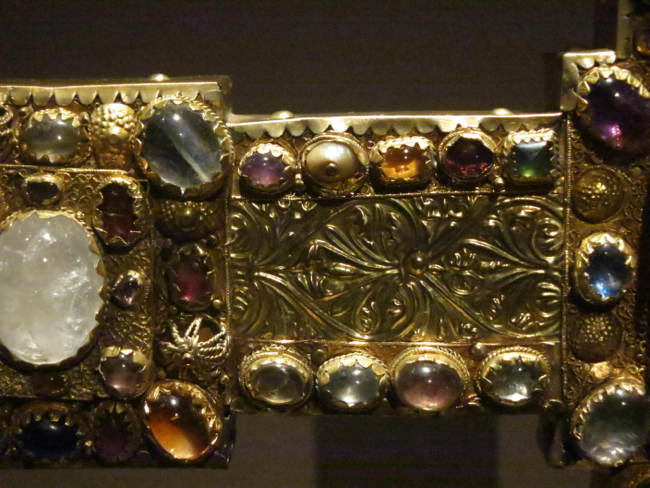
Website Highlights
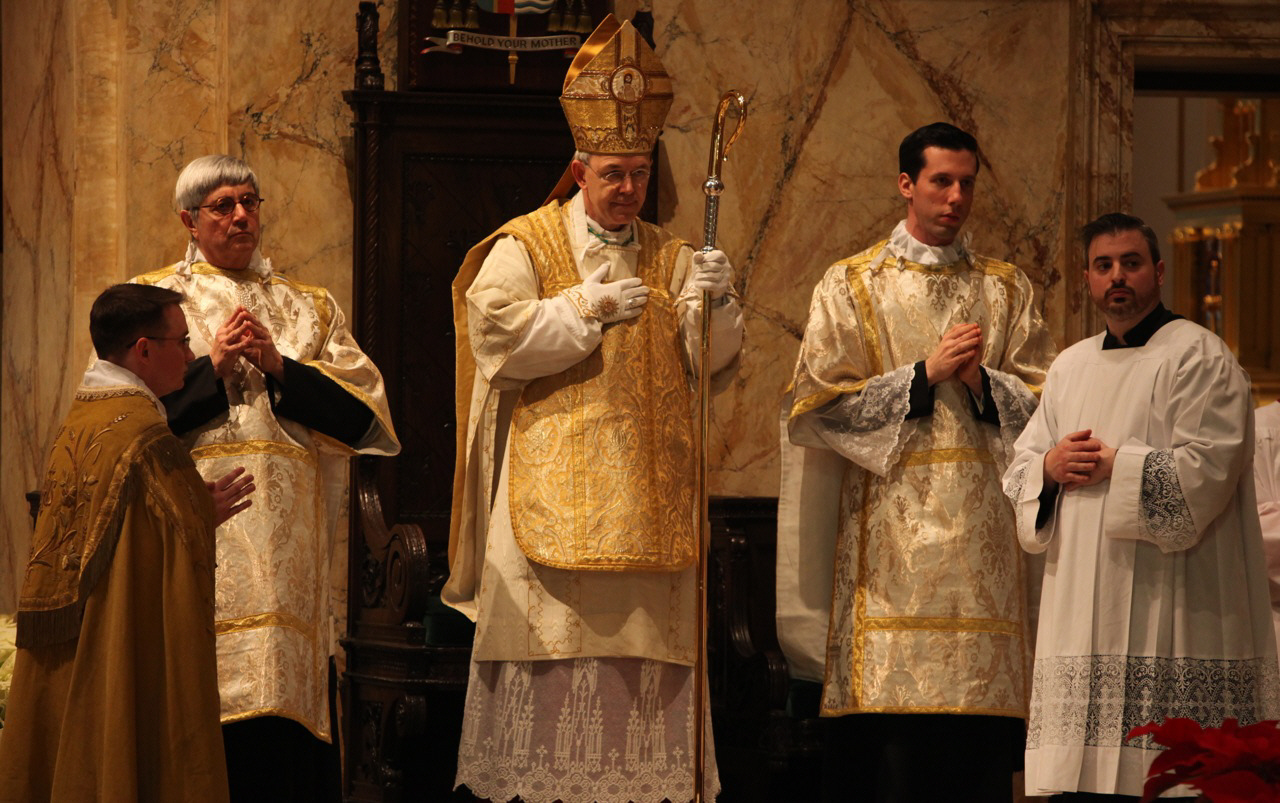
Archives
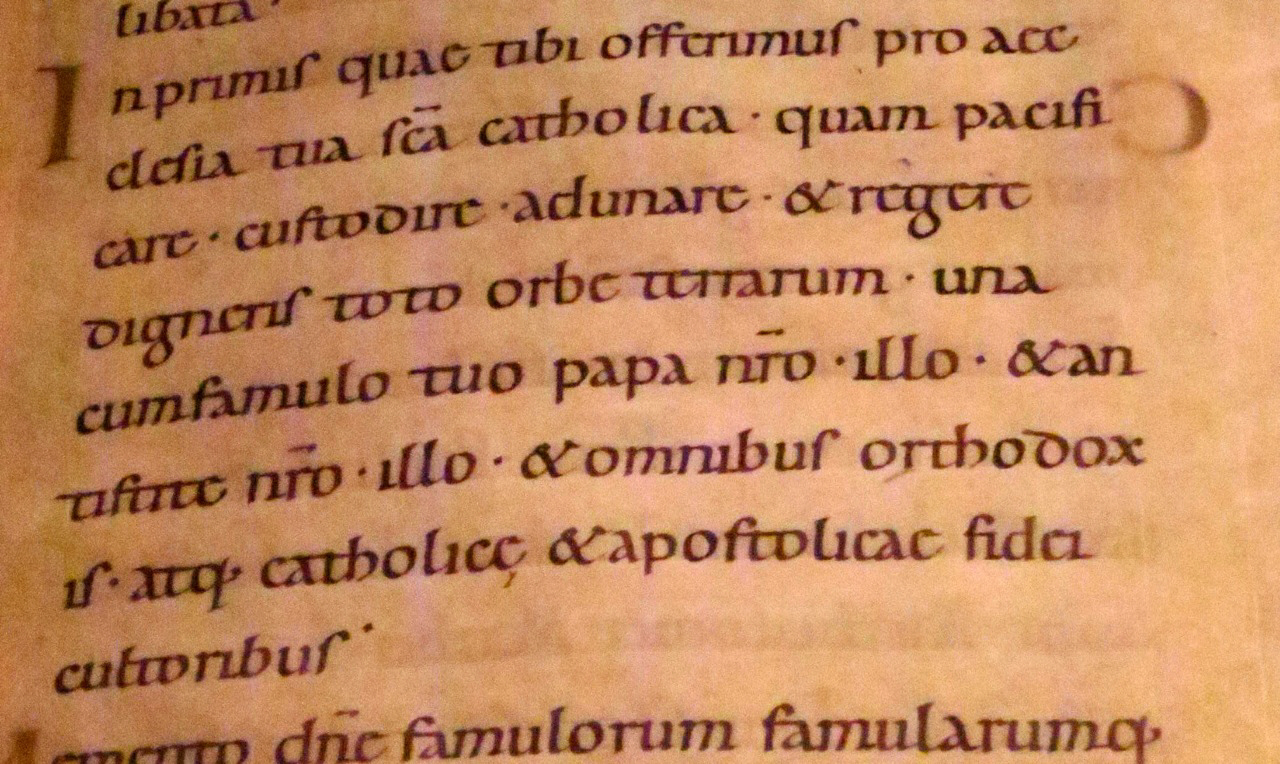
[powr-hit-counter label="2775648"]






